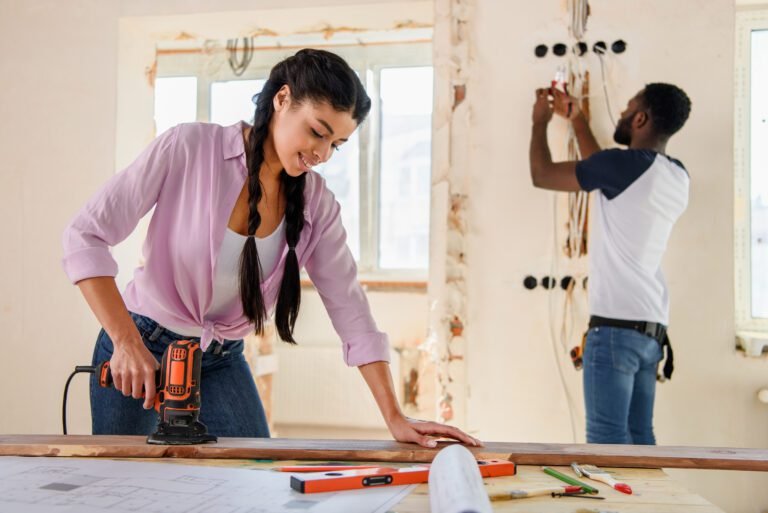Most home improvement injuries don’t happen during the big, obviously dangerous tasks. People are usually pretty careful when they’re cutting through walls or working with power tools they’ve never used before. It’s the routine projects, the ones that feel simple and straightforward, where things tend to go wrong. A quick fix turns into an emergency room visit, and the whole thing could have been avoided with a little more thought about what might actually happen.
The trouble is that experience can work against people here. Someone who’s done a project successfully ten times before gets comfortable, maybe a bit careless. The safety measures that seemed important on the first attempt start feeling unnecessary. Until something goes wrong, and then it’s obvious in hindsight that those precautions existed for a reason.
Skipping Eye Protection for Quick Tasks
This one probably accounts for more preventable injuries than anything else on the list. Drilling a single hole, cutting one board, grinding down a rough edge, these feel too minor to bother with safety glasses. The project will take five minutes, and finding the glasses and putting them on seems like overkill.
Then something flies up and hits an eye. A wood chip, a piece of metal, concrete dust, whatever it is that makes vision go blurry and painful. Most of the time it’s not serious enough for permanent damage, but it’s serious enough for a trip to urgent care and several uncomfortable days while the eye heals. Sometimes it’s worse than that.
The problem gets more complicated for people who wear prescription glasses. Regular eyewear offers essentially no protection from debris, but taking off glasses to put on safety goggles means not being able to see what’s being worked on. The workaround many people use is just hoping nothing happens during the brief time they’re doing whatever task requires both vision and protection. When clear sight is needed for precision work around the garage or workshop, prescription safety glasses online have become a practical option that addresses both needs at once.
The reality is that eye injuries from home projects are common enough that most people either know someone who’s dealt with one or have experienced it themselves. Yet the lesson somehow doesn’t stick, and the same shortcuts keep happening.
Not Turning Off Power at the Breaker
Flipping the light switch off before changing a fixture seems sufficient. The power is off, the room is dark, everything should be safe to work on. Except light switches can be wired wrong, or someone else in the house might flip the switch back on without realizing work is being done, or the circuit might be connected in an unexpected way.
Testing for power with a voltage tester takes about ten seconds. Walking to the breaker box and shutting off the right circuit takes maybe two minutes. These are not significant time investments compared to the alternative of getting shocked, which ranges from startling and painful to actually dangerous depending on the circumstances.
The same principle applies to water shutoffs. Turning off the valve under the sink might stop the flow, but if that valve fails or wasn’t fully closed, water damage happens fast. Finding the main shutoff and using it instead provides a backup layer of protection that costs almost nothing in extra effort.
Underestimating What Needs Support
A lot of DIY injuries happen because something heavy fell on someone or collapsed unexpectedly. A shelf that wasn’t anchored properly. A piece of drywall that got propped against a wall instead of laid flat. Tools or materials stacked in ways that seemed stable but weren’t.
The issue usually isn’t that people don’t know better. It’s that they’re in the middle of a project, juggling multiple tasks, and taking the time to properly support or secure something feels less important than keeping the work moving forward. Then gravity does what gravity does, and something comes down at exactly the wrong moment.
This extends to ladders too. Using the right ladder for the height needed, making sure it’s on stable ground, having someone hold it if the angle is questionable, these basics get skipped surprisingly often. Ladder falls are one of the most common sources of serious home improvement injuries, and most of them involve situations where the person knew the setup wasn’t ideal but decided it would probably be fine.
Mixing Incompatible Materials Without Research
Chemical reactions between different products cause problems that people often don’t see coming. Certain cleaners mixed together create toxic fumes. Some paints or finishes don’t bond properly with particular primers or previous coatings. Adhesives might work great on one material but fail completely or cause damage on another.
The information about what works together and what doesn’t is usually available, either on product labels or through a quick search online. But when someone is already at the project stage with materials in hand, stopping to verify compatibility feels unnecessary. The assumption is that if both products are sold for similar purposes, they should work together fine.
That assumption gets people into trouble fairly often. Paint peeling off days after application because the prep wasn’t right for that specific combination. Adhesive that never fully sets because it’s incompatible with the surface. Fumes that make the whole house smell terrible or cause breathing problems because two cleaning products shouldn’t have been used in the same space.
Forgetting About What’s Behind the Surface
Cutting into walls, drilling through floors, or even hanging something heavy all carry the risk of hitting something that shouldn’t be hit. Electrical wires, plumbing pipes, gas lines, they all run through spaces that look like solid wall or ceiling from the outside.
Stud finders help locate the framing, and some models can detect wiring and pipes too. These tools aren’t perfect, but they catch enough potential problems to be worth using. The people who skip this step are usually the ones who’ve done similar work before without incident, so they figure they have a sense for where things are likely to be.
Until the drill bit goes through a water line, or a saw cuts into electrical wiring, or a nail goes into a gas pipe. The consequences range from annoying to dangerous, and the time saved by not checking beforehand doesn’t come close to making up for the time and money spent fixing the damage.
Not Having a Plan for When Things Go Wrong
Most home improvement projects assume everything will go according to plan. The measurements will be right, the materials will behave as expected, the existing conditions will match what’s anticipated. When those assumptions don’t hold up, which happens fairly often, people end up improvising solutions on the spot.
Some improvisation is fine and even necessary. But improvising without the right tools, materials, or knowledge leads to shortcuts that create new problems. Forcing something to fit that doesn’t quite work. Using materials for purposes they weren’t designed for. Making structural changes without understanding the implications.
Having a backup plan, or at least a “stop and reassess” point built into the project, helps prevent these cascading mistakes. It’s okay to pause and figure out the right approach rather than pushing forward with something that’s clearly not working. The project might take longer, but it’s less likely to result in something that needs to be redone or, worse, creates a safety issue down the road.
Learning the Easy Way or the Hard Way
The pattern across all these mistakes is pretty clear. They’re things people know they should do differently, but in the moment other priorities take over. Speed, convenience, confidence that nothing will go wrong this time, these all contribute to skipping steps that exist for good reasons.
Some people learn these lessons through their own mistakes. Others learn by watching someone else deal with the consequences. Either way, the lesson is the same. The small precautions aren’t there to waste time, they’re there because enough people got hurt or created problems that the precaution became standard advice. Taking an extra minute to do things right prevents hours or days of dealing with preventable complications.


































